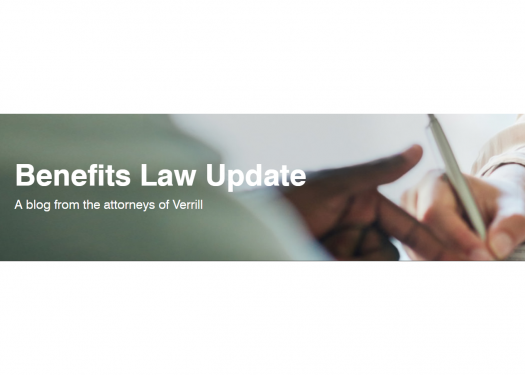Category: Retirement Plans
Safe Harbor Exception for De Minimis Dollar Amount Reporting Errors
As part of the routine administration of employee benefit plans, shortly after the end of a calendar year, many transactions must be reported to the federal government (“information returns”) and participants (“payee statements”) using forms such as Forms W-2, 1099, 1094, and 1095. As benefits professionals know, errors can—and...
IRS Issues Practical Guidance for Implementing SECURE 2.0 Provisions
The Internal Revenue Service gave retirement plan sponsors end-of-the-year gifts by providing guidance under twelve sections of the SECURE 2.0 Act of 2022 (“SECURE 2.0”). Although Notice 2024-2, released December 20, 2023 (the “Notice”), expressly does not provide “comprehensive guidance,” it does address urgent, practical questions for the implementation...
SECURE 2.0 Provisions with 2024 Implementation Dates
This post summarizes provisions of SECURE 2.0 that retirement plans may need or want to implement for 2024. While no amendments are required for plans heading into 2024, plan operations may see some updates, especially if the plan sponsor wishes to implement some of the new optional features. We...
Proposed Regulations Regarding Long-Term, Part-Time Employees
Newly issued IRS Proposed Regulations regarding the special eligibility and vesting requirements for long-term, part-time employees provide guidance that 401(k) plan sponsors have been waiting for since these requirements were established under SECURE 1.0. Though it has been three years since SECURE 1.0 was enacted, the Proposed Regulations were...
Use of Retirement Plan Forfeitures: The IRS Proposed Regulations, Recent Litigation, and the DOL’s Position
In five recently filed class action lawsuits, [1] 401(k) plan participants allege that plan fiduciaries violated ERISA by using plan forfeitures to offset employer contributions instead of paying plan expenses. The use of forfeitures to offset employer contributions is a long-standing practice expressly approved by IRS proposed regulations issued...
Maine’s Mandatory Retirement Savings Program: What Employers Need to Know
On October 18, 2023, the Maine Retirement Savings Board adopted a final rule implementing Maine’s state-run retirement savings program, the Maine Retirement Investment Trust or MERIT. MERIT is intended to help employees who do not have access to a retirement plan through their employer save for retirement by requiring...
Catch-Up Contributions: IRS Provides Relief from Roth Requirements of SECURE 2.0
On August 25, 2023, the IRS issued IRS Notice 2023-62 , providing much needed relief for employers who have been struggling to implement Section 603 of the SECURE 2.0 Act of 2022 (“SECURE 2.0”), which requires high income employees to make all catch-up contributions to 401(k), 403(b), or governmental...
Update on the Debate over Environmental, Social, and Corporate Governance Investing
The debate over investment of retirement plan funds based on environmental, social, and corporate governance (“ESG”) factors continues to make waves. This post provides a high-level overview of the current state of play for plans that are subject to ERISA. We last wrote about this topic in October 2021...
Establishing Practices and Procedures to Support Self-Correction of Operational Failures
The self-correction of retirement plan operational failures under IRS correction principles has been conditioned upon a plan sponsor’s establishment of compliance practices and procedures since the creation of the Employee Plans Compliance Resolution System (“EPCRS”) 25 years ago. This condition was articulated in IRS Revenue Procedure 98-22, which refined...
Reasonable Compensation Under ERISA: Thoughts on Two Recent Cases
Two recent court decisions bring into focus two seldom-asked questions about the reasonable compensation requirement under ERISA. When must an ERISA plan’s service provider compensation be reasonable? And why shouldn’t a plan fiduciary be able to receive reasonable compensation from the plan even if the fiduciary had a hand...
New Options for Retirement Plan Distributions Under SECURE 2.0
This post summarizes the new distribution options, including penalty-free withdrawals, applicable to defined contribution plans under the SECURE 2.0 Act of 2022 (“SECURE 2.0”) and provides a timeline of their effective dates. The new options further evidence Congress’s growing appetite for approving legislation that allows greater pre-retirement access to...
Alternatives for Sponsors of Defined Benefit Pension Plans
For decades, it was common for employers to maintain employer-funded defined benefit pension plans (“DB Plans” or “Plans”) to provide retirement benefits to their employees. In recent years, DB Plans have become increasingly expensive and difficult to administer due to funding, insurance premiums, and government filing requirements. As a...
Proposed Regulations on How to Use Forfeiture Accounts: Helpful Guidance and a Great Reminder to Plan Sponsors
On February 27, 2023, the IRS published proposed regulations on the use of forfeitures in qualified retirement plans. [1] For defined contribution plans, the regulations provide welcome clarity on what forfeitures can be used for and the date by which forfeitures must be used. In addition, they provide a...
Casting a Wider Net: SECURE 2.0 Gives “Long-Term Part-Time Employees” Faster Access to 401(k) Plans and 403(b) Plans
The SECURE 2.0 Act of 2022 (“SECURE 2.0”) promotes and expands access to retirement plans for American workers in several ways. Among other things, SECURE 2.0 strengthens and expands the special 401(k) plan eligibility requirements for long-term part-time workers established by the Setting Every Community Up for Retirement Enhancement...
Pension-Linked Emergency Savings Accounts: Something Old, Something New, Something Borrowed, Something Forthcoming
Following the initial flurry of publications summarizing the retirement plan enhancements under the SECURE 2.0 Act of 2022 (“SECURE 2.0”), this post takes a deeper dive into one of those enhancements: the optional “pension-linked emergency savings account” (“PLESA”). Plan sponsors may add PLESAs to their defined contribution retirement plans...
Next Steps for Making Collective Investment Trusts Available to More Retirement Plans
Collective investment trusts (“CITs”) have become an increasingly popular choice for 401(k) plan investment menus over the past decade, consistent with a trend toward lower-cost investment options that has been driven, in part, by widespread litigation. However, certain technical restrictions have kept CITs from being offered as investment options...
401(k) Plan Matching Contributions: To True Up or Not True Up?
As a matter of plan design, for purposes of matching contributions some 401(k) plans provide that a participant’s compensation for the entire plan year is taken into account (regardless of whether the participant makes elective deferrals with respect to each payroll period during the year), while other 401(k) plans...
New IRS Determination Letter Program for 403(b) and 401(a) Plans
On November 7, 2022, the IRS issued Revenue Procedure 2022-40 , which allows certain tax-exempt employers (such as schools, charities, and churches) to apply for IRS determination letters on their individually designed section 403(b) retirement plans (“403(b) plans”) in substantially the same manner as plan sponsors of individually designed...
IRS Announces New Pilot Program for Retirement Plan Audits
On June 3, 2022, the Internal Revenue Service (“IRS”) announced a new pre-examination compliance pilot program beginning in June 2022. Under the pilot program, the IRS will notify a plan sponsor by letter that its retirement plan has been selected for examination and will provide the plan sponsor with...
Required Minimum Distributions and Missing Plan Participants

In January of 2021, we published two blog posts regarding Department of Labor (“DOL”) guidance on missing retirement plan participants. The first post describes DOL guidance on best practices for locating missing retirement plan participants. The second post describes the DOL’s Terminated Vested Participants Project (“TVPP”), which was initiated...
Revenue Procedure 2021-30: A New and (Further) Improved EPCRS
The Internal Revenue Service has updated the Employee Plans Compliance Resolution System (EPCRS) in several respects that will be helpful to retirement plan sponsors. Revenue Procedure 2021-30 , published July 16, 2021, replaces the previous version ( Rev. Proc. 2019-19 ) in its entirety. Most provisions of the new...
Retirement Plan Administrators: Are You Ready to Comply with the New Lifetime Income Disclosure Requirement for Benefit Statements?
Lifetime Income Disclosure Requirement . The Setting Every Community Up for Retirement Enhancement Act of 2019 (the “SECURE Act”), enacted December 20, 2019, added a new annual disclosure requirement for benefit statements to participants and beneficiaries. The new disclosure requirement applies to all ERISA-covered defined contribution plans ( e.g...
Employee Benefits & Executive Compensation 2021 Summer Client Advisory
Click here to view as a PDF. This Client Advisory summarizes developments in the law governing employee benefit plans prompted by the COVID-19 pandemic. We explain what these developments mean for plan sponsors and highlight the need to adopt plan amendments within limited time periods in order to fully...
Do You Understand Your Investment Policy Statement?
The Acme Rocket Sled Company Retirement Plan Administration Committee recently selected a new investment advisor for the company’s 401(k) plan. During the RFP process, the new advisor observed that the Investment Policy Statement (IPS) that the committee adopted many years ago was a bit thin and out of date...
Supreme Court will Hear Northwestern University 403(b) Plan Excessive Fee Case
The United States Supreme Court will weigh in on the spate of recent lawsuits filed against colleges and universities related to the schools’ retirement plans. The Court has granted a request for review from participants in two 403(b) retirement plans sponsored by Northwestern University. The participants seek to overturn...
Understanding Your Fiduciary Responsibilities Under ERISA: A Webinar
Employers have long understood the importance of fiduciary compliance with respect to 401(k) plans and other retirement plans subject to ERISA, and most have sound processes and governance structures in place to ensure the fulfillment of their fiduciary duties. Many employers, however, do not apply the same level of...
Order of Benefit Deductions from Employee Pay
From time to time we field questions about the order in which deductions for various employee benefits ( e.g. , 401(k) plan elective deferrals and insurance premiums for welfare benefit plan benefits) should be taken from an employee’s pay. The questions range from whether ERISA mandates a specific order...
Partial Plan Terminations – An Update
In our April 2020 post , we detailed how employee layoffs can cause a qualified retirement plan to undergo a “partial termination,” resulting in required 100% vesting of the affected employees’ benefits. As 2020 drew to a close, with the COVID-19 pandemic continuing to affect many businesses, Congress enacted...
DOL Guidance on Missing Pension Plan Participants - Part II
On January 18, we published a blog post regarding new Department of Labor (“DOL”) guidance on missing plan participants. That post is available here , and describes the DOL’s guidance on Missing Participants - Best Practices for Pension Plans (“Best Practices”). This blog post addresses two other pieces of...
DOL Guidance on Missing Pension Plan Participants
The Department of Labor (“DOL”) has undertaken a nationwide compliance initiative to ensure that retirement plan participants receive the benefits that they were promised when they reach their retirement age. To that end, the DOL recently issued three pieces of guidance – (i) Missing Participants - Best Practices for...
Page 1 of 4









